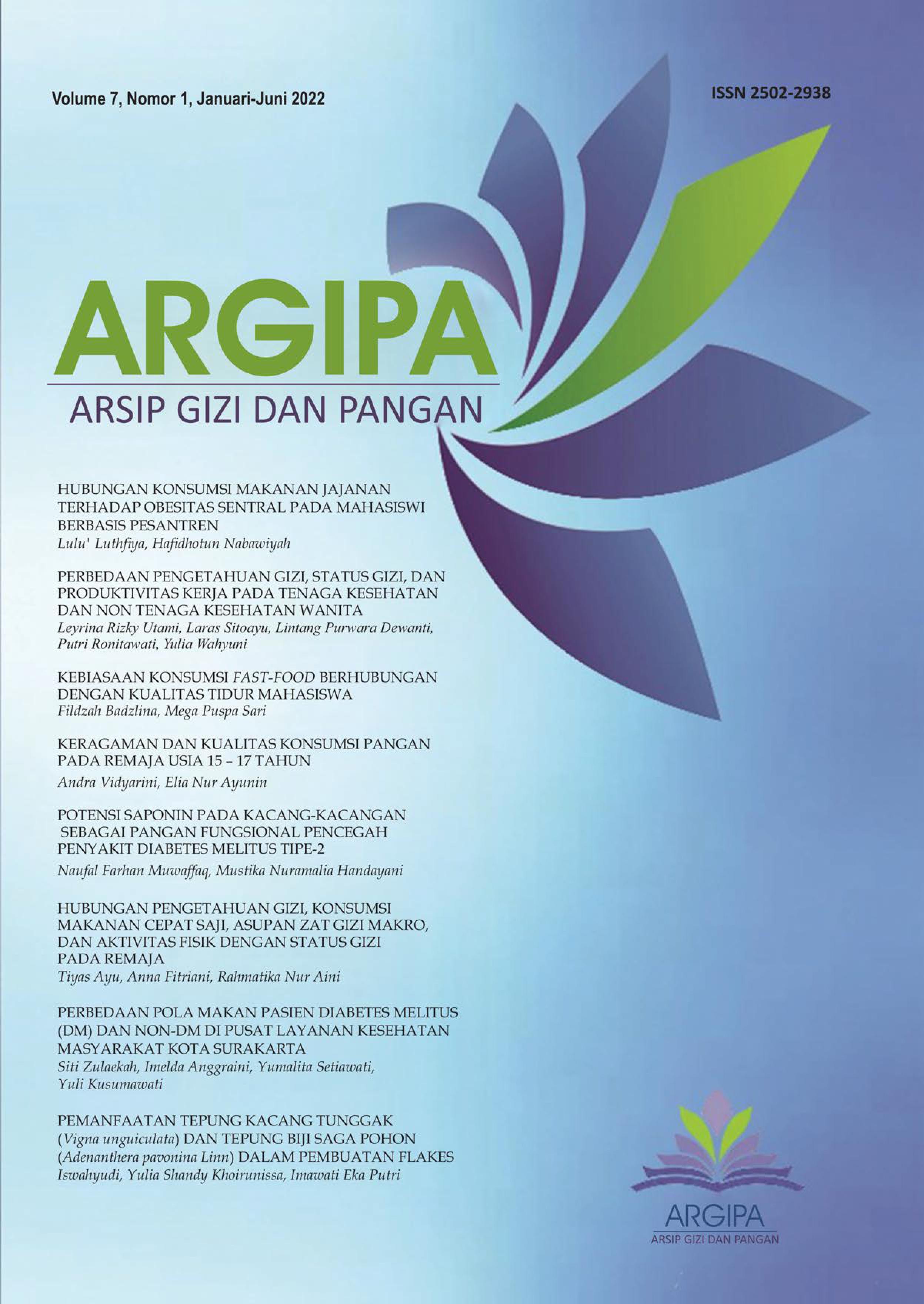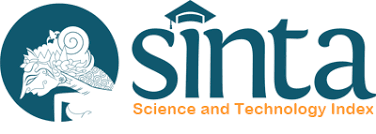The difference of diabetes mellitus (DM) and non-DM patients' dietary habits at the community health service center of Surakarta city
Keywords:
dietary habit, Diabetes Mellitus, Chronic Disease Management Program (CDMP)Abstract
An unhealthy diet is one of the risk factors for non-communicable diseases (PTM), especially diabetes mellitus (DM) and hypertension. The application of a healthy lifestyle is the management of DM with the application of medical nutrition therapy. This study aimed to analyze the differences in energy intake, carbohydrates, cholesterol, glycemic load of food consumed between DM and non-DM patients at Chronic Disease Management Program (CDMP) in the Surakarta Primary Health Center (PHC). This observational study was conducted with a case control design. The samples were 32 DM patients and 32 non-DM patients participating in CDMP at the Jayengan, Penumping, Sibela, Pucang Sawit, Gajahan, and Manahan PHC. The samples were taken by consecutive sampling. Dietary data including energy intake, carbohydrates, cholesterol and glycemic load consumed by subjects during the last three months were obtained through direct interviews using the Semi Quantitative Food Frequency Questionnaire (SQ-FFQ) form and analyzed using the Nutri Survey 2007 program. Analysis of differences in energy intake, carbohydrates and cholesterol in both groups using the Independent T-Test. The results showed that the diet pattern in the DM group has the sufficient energy intake (40.6%), most of the carbohydrate intake in the DM group was excessive (87.5%). Cholesterol intake in the DM group was as recommended (50%), in the DM group, the consumption of the glycemic load was high (97.3%). There were differences in energy intake and glycemic load between DM and non-DM patients at the Surakarta City Health Center. On the other hand, there were no differences in carbohydrate and cholesterol intake between DM and non-DM CDMP patients.
Downloads
References
American Diabetes Association, A. 2012. Diagnosis and clasification diabetes mellitus. Diabetes Care. USA.
Arora, S. & Farlane, S. 2005. The case low carbohydrate diets in diabetes management. Nutrition and Metabolisme, 16(2).
Augustin, L.S.A., Kendall, C.W.C., Jenkins, D.J.A., Willett, W.C., Astrup, A., Barclay, A.W., Björck, I., Brand-Miller, J.C., Brighenti, F., Buyken, A.E., Ceriello, A., La Vecchia, C., Livesey, G., Liu, S., Riccardi, G., Rizkalla, S.W., Sievenpiper, J.L., Trichopoulou, A., Wolever, T.M.S., Baer-Sinnott, S. & Poli, A. 2015. Glycemic index, glycemic load and glycemic response: An International Scientific Consensus Summit from the International Carbohydrate Quality Consortium (ICQC). Nutrition, Metabolism and Cardiovascular Diseases, 25(9): 795–815. http://dx.doi.org/10.1016/j.numecd.2015.05.005.
Baghdasarian, S., Lin, H.P., Pickering, R.T., Mott, M.M., Singer, M.R., Bradlee, M.L. & Moore, L.L. 2018. Dietary cholesterol intake is not associated with risk of type 2 diabetes in the framingham offspring study. Nutrients, 10(6).
Black, J.M. & Hawks, J.H. 2014. Keperawatan Medikal Bedah: Manajemen Klinis Untuk Hasil yang Diharapkan. 8 buku 2. Singapore: Elsevier.: Elsevier.
Brown, C.. 2006. Penyakit Aterosklerotik Koroner, dalam 2(6): 579-585. Jakarta: EGC. PenditB.U., Hartanto;H., Wulansari;P., Susi;N., & D. A. Mahanani, eds. Jakarta: EGC.
Colberg, S.R., Sigal, R.J., Yardley, J.E., Riddell, M.C., Dunstan, D.W., Dempsey, P.C., Horton, E.S., Castorino, K. & Tate, D.F. 2016. Physical activity/exercise and diabetes: A position statement of the American Diabetes Association. Diabetes Care, 39(11): 2065–2079.
Dinas Kesehatan Kota Surakarta. 2019. Proporsi kejadian diabetes mellitus tahun 2019. Surakarta. Surakarta.
Fernandez, M.L. & Andersen, C.J. 2014. Effects of dietary cholesterol in diabetes and cardiovascular disease. Clinical Lipidology, 9(6): 607–616.
Hartono, B. 2010. Promosi Kesehatan di Puskesmas dan Rumah Sakit. Pertama. Jakarta: Rineka Cipta.
Isnaini, N. & Ratnasari. 2018. Faktor Risiko Mempengaruhi Kejadian Diabetes Tipe Dua. Jurnal Keperawatan dan Kebidanan Aisyah, 14(1): 59 – 68.
Juleka, J., Asdie, A.H. & Susetyowati, S. 2005. Hubungan pola makan dengan pengendalian kadar glukosa darah pengidap diabetes melitus tipe 2 rawat jalan di RSU Gunung Jati Cirebon. Jurnal Gizi Klinik Indonesia, 2(1): 13.
Kementerian Kesehatan RI. 2018. Laporan Riskesdas 2018. Laporan Nasional Riskesdas 2018, 53(9): 154–165. http://www.yankes.kemkes.go.id/assets/downloads/PMK No. 57 Tahun 2013 tentang PTRM.pdf.
Khatulistiwa, N.A. 2013. Proses Terjadinya Kaitannya Antara Peranan Zat Gizi dan Penyakit Degeneratif Hipertensi. Universitas Airlangga.
Kholidha, Tien, Pranita, A. & Nirmala, F. 2018. Hubungan Kadar Kolesterol Total dan Trigliserida dengan Kejadian Diabetes Mellitus Tipe 2 di Daerah Pesisir Kota Kendari. Medula, 5(2): 448–453.
Lin, H.P., Baghdasarian, S., Singer, M.R., Mott, M.M., Bradlee, M.L., Pickering, R.T. & Moore, L.L. 2018. Dietary cholesterol, lipid levels, and cardiovascular risk among adults with diabetes or impaired fasting glucose in the Framingham Offspring study. Nutrients, 10(6). doi: 10.3390/nu10060665.
Liu, J., Sempos, C., Donahue, R.P., Dorn, J., Trevisan, M. & Grundy, S.M. 2005. Joint distribution of non-HDL and LDL cholesterol and coronary heart disease risk prediction among individuals with and without diabetes. Diabetes Care, 28(8): 1916–1921. doi: 10.2337/diacare.28.8.1916
Meng, Y., Bai, H., Wang, S., Li, Z., Wang, Q. & Chen, L. 2017. Efficacy of low carbohydrate diet for type 2 diabetes mellitus management: A systematic review and meta-analysis of randomized controlled trials. Diabetes Research and Clinical Practice, 131: 124–131. http://dx.doi.org/10.1016/j.diabres.2017.07.006.
PERKENI. 2015. Pengelolaan dan Pencegahan Diabetes Melitus Tipe 2 di Indonesia. Jakarta.
Persagi dan AsDI. 2019. Penuntun Diet dan Terapi Gizi. Empat. Jakarta: EGC: Penerbit Buku Kedokteran.
Prasetyaningrum, Y.N. 2014. Hipertensi Bukan untuk Ditakuti"¯: Tetap sehat dengan Pengaturan Pola Makan. Jakarta: Gramedia Pustaka.
Prasetyo, M., Hendrartini, J., Muttaqien, Z., Sari, F. & Dewi, T. 2020. A qualitative study to explore the perception of patients towards diet in Javanese culture ଔ. Enfermería Clínica, 30: 183–187. https://doi.org/10.1016/j.enfcli.2020.06.041.
Rimbawan dan Siagan, A. 2004. Indeks Glikemik Pangan. Jakarta: Penebar Swadaya.
Schenck-Gustafsson, K. 2009. Risk factors for cardiovascular disease in women. Maturitas, 63(3): 186–190.
Setyorogo, S. & Trisnawati, S.. 2013. Faktor Resiko Kejadian Diabetes Melitus Tipe II Di Puskesmas Kecamatan Cengkareng Jakarta Barat Tahun 2012. Jurnal Ilmiah Kesehatan, 5(1): 6–11.
Sigarlaki, H.J.O. 2006. Karakteristik dan faktor berhubungan dengan hipertensi di desa bocor, kecamatan bulus pesantren, kabupaten kebumen, jawa tengah, tahun 2006. Makara, Kesehatan, 10(2): 78–88.
Soviana, E. & Maenasari, D. 2019. Asupan Serat, Beban Glikemik Dan Kadar Glukosa Darah Pada Pasien Diabetes Melitus Tipe 2. Jurnal Kesehatan, 12(1): 19–29.
Waspadji, S. 2005. Diabetes mellitus: mekanisme dasar dan pengelolaan yang rasional, jakarta:pusat diabetes dan lipid RSCM-FK UI; 2005;34. S. Soegondo, P. Soewondo, & I. Subekti, eds. Jakarta: Pusat Diabetes dan Lipid RSCM FK UI.
Webster-Gandy, J. 2020. Oxford Hand Book Nutrition and Diabetic. 3 st. America: Oxford University Press.
World Health Organization. 2016. Global Report on Diabetes. Isbn, 978: 88. http://www.who.int/about/licensing/%5Cnhttp://apps.who.int/iris/bitstream/10665/204871/1/9789241565257_eng.pdf.
Yang, Y., Li, J.X., Chen, J.C., Cao, J., Lu, X.F., Chen, S.F., Wu, X.G., Duan, X.F., Mo, X.B. & Gu, D.F. 2011. Effect of elevated total cholesterol level and hypertension on the risk of fatal cardiovascular disease: A cohort study of Chinese steelworkers. Chinese Medical Journal, 124(22): 3702–3706. doi: 10.3760/cma.j.issn.0366-6999.2011.22.018.
Yosmar, R., Almasdy, D. & Rahma, F. 2018. Jurnal Sains Farmasi Dan Klinis. Survei risiko penyakit diabetes melitus terhadap kesehatan masyarakat kota padang, 5(Agustus 2018): 134–141. http://jsfk.ffarmasi.unand.ac.id

















